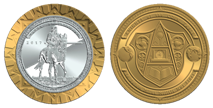Today in my reading, I discovered that there are basically two types of chopmarks. There are the type 1 chops, which are seen on the two Mexican 8 Reales coins above. Then, the American and British Trade Dollars both display the type 2 chop marks. Type 1 can be found through out the history of Silver Coins in China, but the type 2 chops are seen only during the latter half of the 19th century.
The Chinese basically determined foreign silver coins to be similar to their ancient sycee silver ingots. However, the sycee were governed strictly by laws requiring the mint/forgers to be held responsible if the fineness of the silver was less than expected. The coins from foreign governments had no such laws governing them, and so the system of 'chopping' them to display the interior was used heavily.
Many coins in China were hollowed out and filled with lead, or counterfieted so that the Chinese merchant community had strict policies on what authentications must be done before any coin could be accepted. Thus, the special chopmarks developed over time. The Mexican Colonial Dollars became the currency of choice, for many years! When Mexico declared independence from Spain, the Mexican Eagle Dollars took the place of the Colonial Currency, about -fifty- years after the declaration.
Toward the end of the 19th century, Chinese merchants began to see the foreign trade dollars as being defaced by the multitudes of chops added to them. In some instances, the only original surface left on the coin was the VI, VII of the King's name from Spain. They changed to the larger size chopmark, but used less and less of them.
What is amusing, is that so many countries/traders tried to pass counterfeit or devalued coins to the Chinese. Perhaps we ourselves set the stage for China becoming the World Capitol of fake coins!


